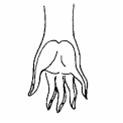Saturday, April 28, 2012
BUDDHA MUDRAS
At the Buddha’s life time, Lord Buddha has different hand gestures and finger-postures which are called “Mudras”. Mudras are a non-verbal mode of communication and self-expression, consisting of hand gestures and finger-postures. They are symbolic sign based finger patterns taking the place, but retaining the efficacy of the spoken word, and are used to evoke in the mind ideas symbolizing divine powers or the deities themselves. The composition of a mudra is based on certain movements of the fingers; in other words, they constitute a highly stylized form of gestural communication. It is an external expression of 'inner resolve', suggesting that such non-verbal communications are more powerful than the spoken word.
Dharmachakra in Sanskrit means the 'Wheel of Dharma'. This mudra symbolizes one of the most important moments in the life of Buddha, the occasion when he preached to his companions the first sermon after his Enlightenment in the Deer Park at Sarnath. It thus denotes the setting into motion of the Wheel of the teaching of the Dharma.
Bhumisparsha mudra
Literally Bhumisparsha translates into 'touching the earth'. It is more commonly known as the 'earth witness' mudra. This mudra, formed with all five fingers of the right hand extended to touch the ground, symbolizes the Buddha's enlightenment under the bodhi tree, when he summoned the earth goddess, Sthavara, to bear witness to his attainment of enlightenment. The right hand, placed upon the right knee in earth-pressing mudra, and complemented by the left hand-which is held flat in the lap in the dhyana mudra of meditation, symbolizes the union of method and wisdom, samasara and nirvana, and also the realizations of the conventional and ultimate truths. It is in this posture that Shakyamuni overcame the obstructions of Mara while meditating on Truth.
Varada mudra
This mudra symbolizes charity, compassion and boon-granting. It is the mudra of the accomplishment of the wish to devote oneself to human salvation. It is nearly always made with the left hand, and can be made with the arm hanging naturally at the side of the body, the palm of the open hand facing forward, and the fingers extended.
Dhyana mudra
The Dhyana mudra may be made with one or both hands. When made with a single hand the left one is placed in the lap, while the right may be engaged elsewhere. The left hand making the Dhyana mudra in such cases symbolizes the female left-hand principle of wisdom. Ritual objects such as a text, or more commonly an alms bowl symbolizing renunciation, may be placed in the open palm of this left hand.
Abhaya Mudra
Abhaya in Sanskrit means fearlessness. Thus this mudra symbolizes protection, peace, and the dispelling of fear. It is made with the right hand raised to shoulder height, the arm crooked, the palm of the hand facing outward, and the fingers upright and joined. The left hand hangs down at the side of the body. In Thailand, and especially in Laos, this mudra is associated with the movement of the walking Buddha (also called 'the Buddha placing his footprint'). It is nearly always used in images showing the Buddha upright, either immobile with the feet joined, or walking.
Labels:
Dhamma article











1 comments:
Your post was quite informative. Bhumisparsha Mudra is a symbolic gesture and body position that acknowledges a few major moments in the Buddha's life. This is my preferred mudra posture.
Post a Comment